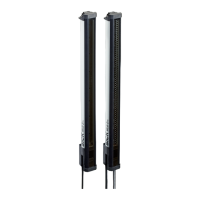2
High-speed scan with 3 beams active simultaneously
The number of beams that can be activated at the same time depends on the size of
the detection area (sensing range, beam separation, and number of beams). On the
MLG-2, the response time, minimum presence time, and reproducibility are displayed
via SOPAS ET. You can also find the response time and minimum presence time when
using the high-speed scan in the diagrams in these operating instructions (see "Dia‐
grams", page 122).
NOTE
With a beam separation of 2.5 mm, the high-speed scan can only be adjusted in combi‐
nation with the high measurement accuracy function.
3.6 Beam separation and minimum detectable object
The measurement accuracy achieved by the MLG-2 depends on the beam separation.
3.6.1 Minimum detectable object with parallel-beam function
In order for an object to be detected continuously, it must completely cover at least one
beam. This is referred to as the minimum detectable object, or MDO.
Figure 12: Minimum detectable object
1
Beam diameter
2
Object is not completely reliably detected
3
Object is reliably detected (meets requirements of minimum detectable object size)
NOTE
For moving objects, the minimum detectable object depends on the speed of the
object.
Beam separation Minimum detectable object (stationary object)
12
2.5 mm 3.5 mm
5 mm 9 mm
10 mm 14 mm
20 mm 24 mm
25 mm 29 mm
30 mm 34 mm
Table 12: Minimum detectable object in relation to the beam separation of the MLG-2
3 PRODUCT DESCRIPTION
22
O P E R A T I N G I N S T R U C T I O N S | MLG-2 Pro 8017460.ZIK1/2017-02-13 | SICK
Subject to change without notice

